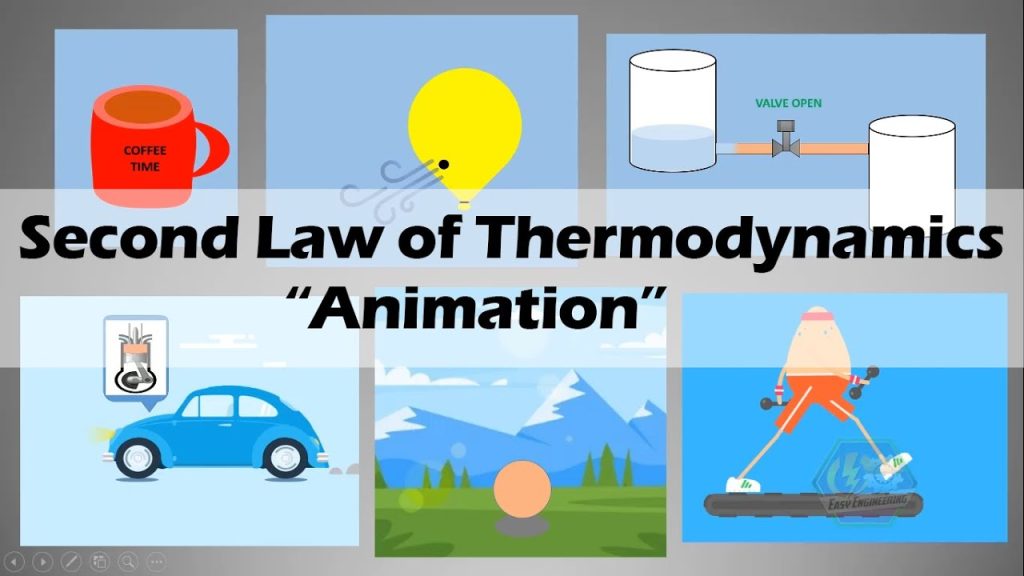This is probably the oldest of all the statements, it says, “The natural tendency of the heat is to flow from high temperature reservoir to low temperature reservoir.” It was based on the findings of Sadi Carnot in 1824, who said that the efficiency of the heat engine is not dependent on the type of working fluid but on the maximum and minimum temperature within the cycle.
Carnot said that the work produced by the engine is not due to consumption of heat; rather it is due to transportation of heat from high temperature reservoir to the low temperature reservoir. The efficiency of heat engine cycle increase as the value of the maximum temperature within the cycle increases and the value of minimum temperature within the cycle reduces. The more is the difference between the maximum and minimum value more is the efficiency of the heat engine cycle. Carnot cycle gives the maximum efficiency that can be obtained in the heat engine cycle.
Second Law of Thermodynamics Statement by Kelvin-Planck
Kelvin-Planck’s statement is based on the fact that the efficiency of the heat engine cycle is never 100%. This means that in the heat engine cycle some heat is always rejected to the low temperature reservoir. The heat engine cycle always operates between two heat reservoirs and produces work.
The statement made by Kelvin-Planck for third law of thermodynamics says, “It is impossible for a heat engine to produce net work in a complete cycle if it exchanges heat only with bodies at a single fixed temperature.” Thus to produce the work the cycle should exchange heat with two reservoirs which are a different temperatures. The high temperature reservoir is called as source and low temperature reservoir is called as sink.
As per the above statement the net work will be produced in the cycle as long as there is difference in temperature between the source and sink. In due course of time if source loses too much heat and sink gains too much heat and their temperatures become equal, the net work produced in the cycle will be zero.
The Kelvin-Planck statement tells the condition for producing work within the cycle, the Carnot’s statement tells maximum work or efficiency that can be obtained within the cycle.
Second Law of Thermodynamics Statement by Clausius
As we know from the previous statement the natural tendency of the heat is to flow from high temperature reservoir to the low temperature reservoir. But what if we have to transfer the heat from low temperature to high temperature reservoir? This has been clarified by Clausius statement of second law of thermodynamics, which says that the reverse transfer of heat never occurs spontaneously.
The statement of second law of thermodynamics made by Clausius goes like this, “It is impossible to construct a device which, operating in a cycle, will produce no effect other than the transfer of heat from a colder to a hotter body.” The statement says that to transfer the heat from low temperature to high temperature reservoir some external work should be done on the cycle. This statement has been the basis for the working for all refrigerators, heat pumps and air-conditioners.
What is Reversed Heat Engine?
The engine is the devise that produces the work by absorbing heat from the high temperature reservoir or source and releasing the remaining heat to the low temperature reservoir or sink. One of the earliest cycles for the heat engine was proposed by Sadi Carnot. The Carnot cycle comprises of two reversible isothermal processes and two reversible adiabatic processes. Since all the processes in Carnot cycle are considered to be reversible, whole cycle is also considered to be reversible. If all the processes of the Carnot cycle are reversed, what we get is a machine which is called as reversed heat engine.
As the name suggests the reversed heat engine works exactly opposite to the heat engine. The heat engine produces work by absorbing heat from the source and liberating some heat to the sink. The reversed heat engine absorbs the work and transfers heat from the sink to the source. That means that the reversed heat engine absorbs work and transfers heat from low temperature reservoir to high temperature reservoir.
The natural tendency of the heat is to flow from the high temperature reservoir to the low temperature reservoir. The concept of reversed heat engine clearly shows that to transfer heat from the low temperature reservoir to the high temperature reservoir external work must be performed on the system. The reversed heat engine comprises of all the processes that the Carnot heat engine has, but they operate in a reverse manner.
The reversed heat engine concept bolsters the findings made by Clausius about second law of thermodynamics. His statement for second law of thermodynamics says, “It is impossible to construct a device which, operating in a cycle, will produce no effect other than the transfer of heat from a colder to a hotter body.” This means that when the devise transfers heat from low temperature to high temperature reservoir, it cannot do so without producing any other effect. This any other effect is absorbing the work. The heat will not flow spontaneously form low temperature to high temperature reservoir; some external work has to be done on it.
Foundation of Refrigerator and Heat Pump
The straight Carnot cycle has led to development of the automobiles that produce the work by absorbing heat from the source and liberating remaining heat to the atmosphere. The concept of reversed heat engine has led to the development of the refrigerator and heat pump. As we know our household refrigerator maintains low temperature inside the freezer by absorbing the heat from this low temperature compartment and liberating it to atmosphere which is at high temperature. For doing so the refrigerator consumes electricity, which is work input.
The air-conditioner and heat pump also work on the same principle. During summers air-conditioner removes the heat from room and liberates it to the atmosphere thus keeping the room cool. The heat pump is useful in winters, it absorbs the heat from atmosphere, which is at low temperature and releases it to the room to keep it hot.
The Carnot cycle and reversed Carnot cycle has led to the major developments in the human history. There is hardly any other cycle which can be as universally applicable as these two.



Comments are closed